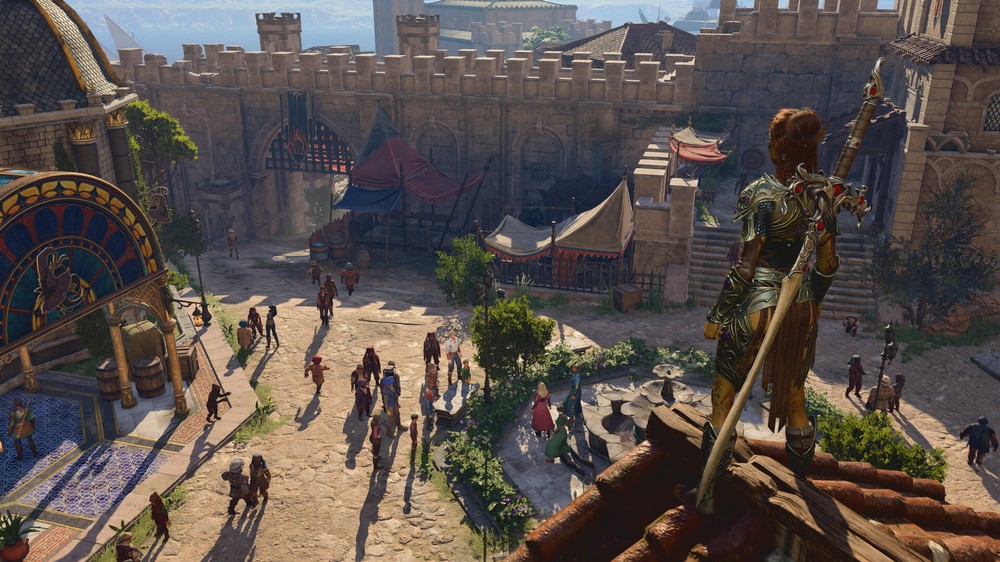Upon meeting my first mind flayer in the opening minutes of Baldur’s Gate III, I said out loud “Oh, just like from Stranger Things.” I bring this up to say, my knowledge of Dungeons & Dragons is very limited, so don’t chuck your twenty-sided die at me in disgust if I misspeak in reference to 5e. With that out of the way, Baldur’s Gate III is one of the most engrossing games I have played in a very long time. I wanted to explore every corner of the Forgotten Realm, talk to every Tiefling, dark elf, and animal that crossed my path, and throw grease on every surface that I could cover it with. With a longer than usual early access window, Larian Studios has made the most of that time and delivered a CRPG playground that bends to many playstyles. If you can think it, you can most likely do it. The game is not without its flaws, but those are hardly enough to take away from the hundreds (maybe thousands) of hours you will spend save scumming around Faerûn.
You’re smacked with your first set of decisions to be made at the character creator screen. Create your own identity or play as an origin-hero (which just puts you in the shoes of one of the companion characters.) This is a nice fork in the road for those who just want to jump in and start playing. For those on the creation side you’ll pick one of the 12 available classes. These include Paladins, Rangers, and Wizards just to name a few. Things get a little more complicated when you get into the subclasses, of which there are 46 total. Your subclass determines a few additional powers and some other aspects of your character. For example, my Oath of the Ancients Paladin spreads hope through acts of kindness and protects love from evil. This gives a general guideline for how you should approach scenarios in that role, but it’s not really anything you have to stick to. I eventually became an oathbreaker after being a complete dick to some Tiefling children.

Further into character creation you pick from 11 races. These again break down into subraces, of which there are 31. I of course went Dragonborn, because of my obsession with dragons. The Dragonborn race breaks down into 10 subraces which all essentially cover a part of the color wheel, and each have a specific dragon breath power and resistance to set them further apart. The character creator is a bit more limited once you get into the actual looks of your character. You can play around with different features like scars, tattoos, and genitalia. You can also switch through a handful of preset faces, but I found the lack of sliders for facial features to be a little head scratching, especially with the class and race selections having much more depth in comparison. Still though, this didn’t stop me from spending what felt like hours pouring my heart and soul into each character.
Baldur’s Gate III opens with an attack on the senses. Your character awakens to an Illithid placing a tadpole parasite in your brain, through your eye socket. The airship you’re imprisoned on is eventually attacked and crashes in Faerûn. Freed from your captor, you, along with numerous other prisoners from the ship, set out to find a way to remove your parasites before they can transform you into Illithids. It’s a simple set-up that while not always the main focus, is constantly lingering in the back of your mind. At this point the game sets you free to run amok. It’s in these opening hours where you’ll meet a good majority of your companions. I was amazed by how fast the party came together. I was equally amazed just how easy it was to miss out on recruiting companions in the early moments of the game.

A conversation with a friend made me realize I had completely missed Gale, forcing me to backtrack from the Underdark to recruit him. The realization that I could have had an extra character for all of act one was a gut punch, especially when I think about how much harder it made things for me. The Emerald Grove side-quest can end in a pretty big battle depending on your decisions. I went into this battle after only recruiting Shadowheart and Astarion. It was a slog that I found myself failing over and over again. I thought I was having a rough go at it because I was terrible at combat. That wasn’t the case. I was having a rough go, because I wasn’t exploring and turning over nearly as many stones as I thought I was. I eventually pulled through that combat encounter thanks to strategically placed explosive barrels and covering the battlefield in grease. My favorite thing about Baldur’s Gate III, aside from greasing everything and everyone up, is hearing the multitude of ways players have tackled the same scenarios. It creates an intrigue that begs the question, “if you can do that, could someone do this” and the answer, more times than not is yes.
A good amount of time in Baldur’s Gate III is figuring out your abilities and how they can be used in the world. Admittingly, the UI is daunting out of the gate. Playing with mouse and keyboard the bottom portion of your screen is ruled by tiles of physical attacks and all the abilities at your disposal. You can switch to a controller, but I personally don’t believe the ability wheels make everything any less daunting. The game is really not interested in holding your hand and for some players this might be a roadblock that keeps them from getting into the campaign. I was annoyed at first with the games disinterest in teaching me how to play. Isn’t a DM responsible for guiding me? But the more time I spent exploring, fighting, and experimenting the more I was willing to engage with all the abilities available to me and my companions. Combat encounters are tougher early on, but after a few level ups and some gear upgrades I found myself fairing much better on the battlefield. It also helped that I wasn’t being overly aggressive and pushing into enemies anymore. Instead, I played into character strengths, like Astarian’s archery, and looked for environmental advantages such as highground, dangerous cliffs, and other traps I could trick enemies into. My change in approach not only made combat more rewarding it made it a much more fun experience.

My biggest gripe with the game centers around the UI. Ability bars and wheels aside, your inventory is a mess to navigate. You can filter items by type and other categories, which can help when you’re doing some spring cleaning. Things become more of an issue when you’re trying to determine equipment loadouts and who should get what armor or weapons. Floating over a set of armor you’ll get a glimpse of its armor class, other than that, most of the time my eyes would glaze over trying to understand the additional costs or benefits of a breastplate or a pair of boots. Same story for weapons. Outside of damage ranges and if a character was proficient with a weapon type, a lot of what I was reading was going over my head. Inventory management is also a mess. You have the ability to move things between your character and your companions. The extra space is nice, but I’d be lying if I said managing four separate inventories was easy for me or something that I actually wanted to do.
The current state of the quest journal makes it hard to keep track of your current objectives. The text is bunched up and some quests have intersecting objectives. The map is much more readable and was my go-to for deciding what I needed to do next. The lack of a bestiary is also concerning. I’m learning an awful lot about an awful lot. A menu to stay fresh on best approaches and things to remember for fighting certain beasts would go a long way here.

If you can’t get enough chaos, you can play through the campaign co-op, with three of your friends. With my limited knowledge, this is the most Dungeons & Dragons you can make Baldur’s Gate III feel. Things can go off the rails as you divide and conquer around the map. I limited my time in co-op to experience the story for myself, but if my short time with human companions was any indicator, it adds a good chunk of hours to a game that’s already got my full attention.
The companions of Baldur’s Gate III are some of the best RPG companions I’ve interacted with since Mass Effect 2. They each feel alive and have purpose beyond just being another party member. The throughline themes of control and power imbalances feed into each companion’s side-quest and tie back neatly to the central conflict with the tadpoles and the Cult of the Absolute. The standouts for me are easily Karlach and Wyll who both find themselves on the bad end of a deal with separate devils. After a long day of battling and exploring, players can set up camp for the night and chat with all their companions. I always found myself looking forward to pitching the tents and setting up camp. This is where all the romance and backstories come into play. From learning about Shadowheart’s upbringing as a dark disciple of Shar and her love-hate relationship with her faith, to Astarian’s hunger getting the best of him. I never knew what interesting bit of new information was going to spill out around the campfire.

I crossed a few bugs in my time with the game. The most annoying were character’s not interacting with some environment, such as being unable to walk through a false wall or getting stuck in stairs. Situations like those mainly resulted in loading a previous quicksave. I did run into the issue of not being able to walk through a fake wall on more than a few occasions. Outside of those, I realize I am one of the lucky ones when it comes to bugs in their time with the game.
It’s hard not to recommend Baldur’s Gate III. Even with the UI gripes, some bugs, and the game’s unwillingness to babysit players, it’s still one hell of a good time. Wandering the Forgotten Realms aimlessly, finding my groove in the combat, being a so-so Paladin, flirting with whoever gives me the time of day, and drenching whatever and whoever I want in grease have been some of my favorite experiences in a game this year. I easily think there’s thousands of hours of fun to be had here, save scum or no save scum.












1 thought on “Baldur’s Gate 3 Review – PC”